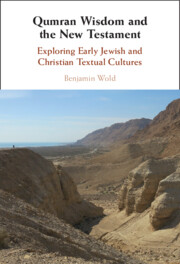Book contents
- Qumran Wisdom and the New Testament
- Qumran Wisdom and the New Testament
- Copyright page
- Dedication
- Contents
- Preface
- Acknowledgments
- Introduction
- 1 Cosmology and Eschatology
- 2 Universalism and Particularism
- 3 Wisdom As Action
- 4 Poverty and Humility
- 5 Debt Remission in the Matthean Lord’s Prayer
- 6 Paul
- Conclusion
- Bibliography
- Index
6 - Paul
Spirit, Flesh, and the Household
Published online by Cambridge University Press: 22 December 2022
- Qumran Wisdom and the New Testament
- Qumran Wisdom and the New Testament
- Copyright page
- Dedication
- Contents
- Preface
- Acknowledgments
- Introduction
- 1 Cosmology and Eschatology
- 2 Universalism and Particularism
- 3 Wisdom As Action
- 4 Poverty and Humility
- 5 Debt Remission in the Matthean Lord’s Prayer
- 6 Paul
- Conclusion
- Bibliography
- Index
Summary
The first five chapters of this study take James and, to a lesser extent, Matthew as their focus. The association of these two compositions with one another and long-standing concern for their relationship to sapiential views and discourse dovetails with explorations of Qumran wisdom. However, in terms of significance for New Testament literature, in the earliest study of Qumran wisdom in the 1990s neither James nor Matthew garnered nearly as much attention as Paul. A feature of Paul’s theology that attracted interest was his negative use of “flesh.” Indeed, several scholars observed that the way the apostle used this idea had its closest parallel in a small handful of Qumran scrolls. Since the first publications on this topic, debates about how precisely Instruction uses flesh language have emerged. How spirit and flesh are understood in this Qumran wisdom composition results in different assessments of significance and meaning for (dis)similarities with Paul. Therefore, it is necessary to tend to debates and translation issues before assessing their relevance for Paul.
- Type
- Chapter
- Information
- Qumran Wisdom and the New TestamentExploring Early Jewish and Christian Textual Cultures, pp. 178 - 206Publisher: Cambridge University PressPrint publication year: 2022

